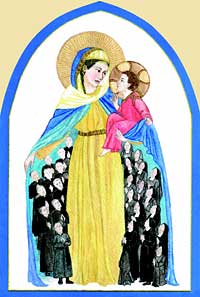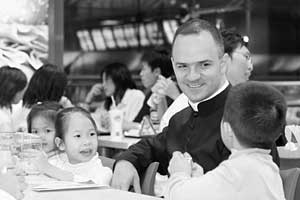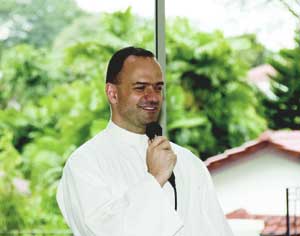

![]()
![]()
|
Newsletter of the District of Asia July - December 2006 Editorial Dear Friends and Benefactors,
As I am writing these lines, the crisis in the Church seems to have entered a new and perhaps, God willing, decisive phase. The real issues at the heart of the crisis in the Church have come up in the clear day light and as a result, the Two Standards, the two opposite armies, who were all mixed up until now for or against the Kingship of Our Lord Jesus Christ, are in the process of lining up their troops in battle array, in a way we may not have seen so far. What has triggered this reaction? It is simply the news which came out on October 11 last (Our Blessed Lady’s Divine Motherhood day) that a Motu Proprio, a short papal document, was finally about to be published giving, it appeal, full freedom, to all priests, to offer the Holy Mass according to the Tridentine Missal. Some observations can be made immediately: firstly, since the Holy Roman Church is built upon the Rock of Peter, only a Pope will be able to restore the Church to its normal status as the One, Holy, Catholic and Apostolic Church. The Conciliar Church is quickly loosing these Four Marks. Everyone of us, though he be a child, a parent, a priest or an Archbishop Lefebvre, have indeed to do our utmost according to the will of God, in our duty of state, for the well-being of the Church. But only the actions of a Pope will succeed in re-capitulating all things, in the whole Church, in Christ. It is the story of Easter Sunday again: when Peter doubted, all the disciples doubted. When Peter finally believed, everyone believed. “The Lord is risen indeed! He has appeared to Simon!” (Lk. 24, 34) If the calamities affecting the Church and the papacy are a dramatic result of the negligence of certain popes in fulfilling their duties and fulfilling heaven’s requests, similarly, the triumph of the Immaculate Heart of Mary will be the result of the action of a pope, that is, the consecration of Russia to the Immaculate Heart. Secondly, it is now explicitly stated, by Conciliar bishops and Cardinals, that there is a contradiction, an opposition between the old Mass and Vatican II. “The bishops are afraid that the generalization of the Roman missal of 1962 would attenuate the guidelines of Vatican Council II. Such a decision would also risk endangering the unity among the priests, and among the faithful as well.” (a statement by Three French Bishops, Oct. 25, 2006) “The bishops expect from these (traditionalists) faithful, a gesture of acceptance, without ambiguity, to the teaching of the Authentic Magisterium of the Church (i.e. Vatican II). (…) The bishops restate the attachment to the liturgical renovation willed by Vatican II Council…” (Declaration of the French Bishops, Nov. 9, 2006) After having been told ad nauseam that the “New Mass was the same as the Old,” that “Don’t worry, nothing is changed!”, now the truth is coming out. These bishops are now admitting that the issue is far deeper than the liturgical one. It is a question of faith. And that the faith expressed in all these liturgical reforms of the last 40 years is different than that expressed by the Traditional Mass. “The disputes with the faithful who have followed Archbishop Lefebvre in his ‘no’ to Rome are not, in the first place, liturgical, but theological, concerning religious freedom, ecumenism, interreligious dialogue.” “We hope to proceed with welcoming those who retain an attachment to the ‘Mass of Saint Pius V’. Diversity is possible – but it must be regulated. It must go together with the unity of the liturgy and the unity of the Church. One must not leave the choice of one of the forms of the Roman rite – the Mass of Saint Pius V or the Mass of Paul VI – to subjectivity alone.” (Idem) How dare they raise the flag of disunity? “The cheek of them!” as the Irish would say. The Catholic Church has been indeed One in its liturgy in the Latin Rite for most of 1200 years especially since Charlemagne imposed throughout his Empire the Roman Rite back in the 800s. All attest that Latin has been a major source of the unity of worship over the centuries. On the other hand, the French Bishops, echoing the voice of so many others, claim implicitly that the New Liturgy is One! How can they pretend that when not even two neighboring parishes in the same village have the same Sunday Mass? It is all up to the creative mood of the local parochial committee. Incredible. Actually, not really. The devil is the father of lies, said Our Blessed Lord, he is the supreme expert in deception. Now we are told all of a sudden that the Old Mass divides, when it was the great source of unity for centuries; now we are told that the liturgy must not be left to “subjectivity alone”, when “subjectivity alone” has practically guided all the liturgical reforms of Vatican II of the last 40 years… We sense a great worry on their part. In this meeting of the French Episcopate, Cardinal Ricard, its president, repeatedly said to his fellow French Bishops not to fear… All this reveals also another major deception: who is really in schism? If by schism, one means to cut oneself from the Communion of the Church, not just that of today, but that of all times, by clearly refusing to question the orientations of the Council — that it clearly broke with the past — are they not showing a true schismatic mentality? “Contrary to the intentions that some attribute to him, Pope Benedict XVI does not intend to double back along the path that Vatican Council II set for the Church. He is solemnly engaged in following it.” (Idem) I could quote here from another document of the Federation of Asian Bishops’ Conference, of October 2006 giving the same idea, from an Asian point of view. It deals with the reception of Vatican II in Asia and how Vatican II has changed the face of Roman Catholicism in Asia. We, in Asia, are now in an Asian Catholic Church, less and less Roman. “The reception of Vatican II’s liturgical reforms in Asia, however, went far beyond the translation of the liturgical books composed by the Roman authorities into vernaculars. It included also an explicit effort of liturgical inculturation by bringing elements of the local cultures into sacramental and liturgical celebrations. This inculturation occurs at many levels. On a more superficial level, it includes the use of local music and songs, vestments, gestures, rituals, sacred objects, architecture. On a deeper level, it involves the composition of new sacramental rituals for significant events in a person life such as marriage and funerals. It sometimes includes the use of sacred writings in addition to the Christian Scriptures. In some countries, sacred rituals such as the cult of ancestors are incorporated into the liturgy. Because of their academic resources and favorable political conditions, two countries have made significant contributions to the reception of Vatican II’s liturgical reform in general, that is, India and the Philippines. Liturgical inculturation is only an aspect of the larger enterprise which Vatican II has spawned in Asia, perhaps more extensively than anywhere else in the Catholic world. Whereas the Catholic Church in Latin America has been more concerned with the socio-economic oppression of the poor and marginalized, and hence was more focused on liberation, Asian Christians, while also concerned with the issues of justice, have been more engaged the inculturation of the Christian faith. In light of these efforts at inculturation, it is clear that by implementing Vatican II’s teaching, the Asian Churches have decisively moved away from the dominant model of mission as the plantatio ecclesiae of the pre-Vatican II era.” (FABC Papers no. 117, G) When have Popes and Bishops in the past rejected all that took place before a Council? Never. The Church is precisely Apostolic, it goes through time unchanged, one Council reiterating what the previous Councils taught, one Pope always referring to his predecessors showing that faith doesn’t change with time. Let us look at another aspect not yet mentioned in all this turmoil: the priesthood, and linked with this, the heroic wisdom of Archbishop Lefebvre. Archbishop Lefebvre once said that he could not conceive how a seminary which had the New Mass could properly train priests, because there was a contradiction between the two. Why? It is because the priest is the man of the sacrifice, firstly of the Holy Sacrifice of the Mass, and secondly he is the minister of the “Religion of the Cross”, as the Catholic Church has often been called. He must live and preach the spirit of the Cross. On the contrary, the New Mass has practically eliminated the mystery of the Cross, both as to its rites and as to its spirit. The traditional liturgy clearly shows the opposition between the teaching of Our Lord Jesus Christ and the world. Expressions such as “to despise the things of this world, to love the heavenly things”, are a regular occurrence in the prayers of the traditional Missal. The New Mass is the liturgical expression of a Council which sought to be open to the world, to modern time, and consequently, as Pope John XXIII said at the beginning of the Council, not only does it seek to avoid clashes (eg. the refusal to condemn communism) but it is always trying to incorporate the spirit of the world. Cardinal Ratzinger stated in a famous interview in 1984 that the Council had made its own two centuries of liberal culture. So, all this touches the very definition of the priesthood, and consequently of the bishops! Modern bishops can no longer identify themselves with the old definition of the priesthood… We often witness an identity crisis when we bring the Traditional Mass to priests and bishops who have more or less lost the link of their priesthood with the Cross of Christ. There are many priests who have received the grace and had the humility to offer the traditional Mass for the first time after 10, 20 years of priesthood. They later openly confessed: “I am discovering what a priest is! It is like saying Mass for the first time!” Another stratagem to try to block this papal Motu Proprio is the assertion that apparently nobody, especially among the priests, is really showing an interest for the Old Mass. Such statements are coming repeatedly from Germany. Well, the Society of St Pius X thinks otherwise, proof in hand. Recently, that is since August last, a leaflet was sent to 7,000 of the 16,500 priests in Germany, informing them that a professional DVD had been made on how to celebrate the Traditional Mass, and that it would be theirs for free just by asking for it. The reply? 1,000 requests out of 7,000… And we are told there is no interest? The same DVD will be available shortly in French, English, Italian and Spanish. And here we touch the heart and the extraordinary wisdom of Archbishop Lefebvre. He was a man of the Church all his life and never wanted to work just for the Society of St Pius X. He wanted to work for the Church, the worldwide, universal Roman Catholic Church. By saving the traditional manner of training priests, by his small Priestly Society which seeks to help all priests — be they young or old, sickly, or fallen away — to be priests as much as possible according to what Our Lord had in mind when He instituted the Sacred Priesthood, Archbishop Lefebvre was truly saving the sacrament which is the most necessary for the survival of the whole Church: the sacrament of Holy Orders. “Though all the Sacraments possess a divine and admirable efficacy, it is well worthy of special remark that all are not of equal necessity or of equal dignity, nor is the signification of all the same. Among them, three are said to be necessary beyond the rest, although in all three this necessity is not of the same kind.The universal and absolute necessity of Baptism, our Savior has declared in these words: ‘Unless a man be born again of water and the Holy Ghost, he cannot enter into the kingdom of God’. Penance, on the other hand, is necessary for those only who have stained themselves after Baptism by any mortal guilt. Without sincere repentance, their eternal ruin is inevitable. Orders, too, although not necessary to each of the faithful, are of absolute necessity to the Church as a whole.” (Catechism of the Council of Trent, The sacraments in general) Perhaps, God willing, in the near future, the providential role of the Society of St Pius X will become clearer than before. The interest in the Traditional Mass of the 1000 priests in Germany, of the 500 others in the USA and of how many others in the months to come, already makes manifest the Catholic mind and heart of Archbishop Lefebvre. Let me finish this rather long editorial with some Asian news. Many have heard of the Indian Orphanage that has joined Tradition. You will find the story in Fr. Chazal’s Letter. In mid-January 2006, the orphanage moved 500 miles south to be near the Traditional Mass, sacraments and priests. Now, it is opening a new chapter with the Foundress of the orphanage, Miss Swarna Vongala, about to join a traditional community of Italian Sisters, the Consolers of the Sacred Heart. As Fr. Chazal justly wrote, “the coming of the orphans is really a turning point for the mission of India; God gives us the opportunity to stoop a little bit better on the misery of India, to extend hopefully the victory of Faith through that of Charity”. The presence of Traditional Sisters will certainly be an extra boost for this victory. After one year of trial, Bishop Fellay has confirmed last August that New Zealand, with its New Caledonian Mission, has been attached to the District of Asia. This is the reason of various reports and photos you will find from now on in our Newsletter. Last summer, the District of Asia saw many of its priests moving around, changing assignments. Four priests left the District for other skies, and were replaced accordingly. As we thank all those who left for their generous work, and heartily welcome the fresh troops, a special mention must be made of Fr. Davide Pagliarani who has left Singapore, after a short three years of intensive work and travels, to take the difficult responsibility of the District of Italy. We assure him of our prayers for the delicate role he will play in the vicinity of Rome. Finally, this coming Christmas, two deacons of the District will receive, God willing, the grace of the Sacred Priesthood: Rev. Fidel Ferrer, a native of Manila, Philippines, who will be ordained on Dec. 23, in the seminary of Our Lady Co- Redemptrix, in La Reja, Argentina, and Rev. Michael Lavin, from Wanganui, New Zealand who will receive the same grace in our Holy Cross Seminary, in Goulburn, in Australia on Dec. 27. With the assurance of my prayers for a fruitful season of Advent and a blessed Christmas, I remain yours truly in the service of Our Blessed Lord and of His Holy Roman Catholic Church.
Fr. Daniel Couture
“Let
the little children come to me!”
Fr. Davide Pagliarani’s farewell speech to the Asian Missions,
|


